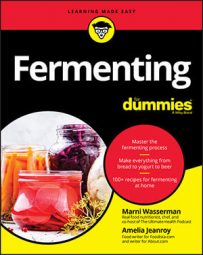True vinegar is more than the flavor behind a dill pickle. Vinegar in its raw form is actually a living food, containing the beneficial bacteria you need to digest your food properly.
Several types of vinegars are used in cooking. Some of them are commonly found in a well-stocked pantry, while others are usually found in a specialty store or the specific country where they're used.
For the most part, the vinegar found on your grocery store shelf isn't a true vinegar, or it has been pasteurized to kill the beneficial bacteria inside. In fact, many vinegars are simply flavored and colored white vinegar. Be sure to read the label and look for the words raw and unpasteurized.
Adding vinegar to a food is pickling, not fermenting. You can enjoy pickled foods and fermented foods, but they're not interchangeable.
Here are some of the vinegars you'll find commercially:
Apple cider vinegar: Brown in color, this vinegar is available raw, with the mother still visible. It's usually a naturally fermented product, but read the label to see whether it's simply white vinegar that has been colored to look like cider vinegar.
If you buy a bottle of pasteurized apple cider vinegar, you can add the mother (the spongy mass that forms in unpasteurized vinegar) to it and replenish the beneficial bacteria that were killed during the pasteurization process. Simply add a tablespoon of raw apple cider vinegar to the new bottle of pasteurized vinegar and allow it to sit for about a week. You'll see the mother beginning to form on the bottom of the new vinegar bottle.
Balsamic vinegar: Made from grapes, this almost black vinegar is aged for many years. The flavor is complex, and it's used in dishes that can showcase the unique flavor.
Fruit vinegars: These vinegars are made from the fruit that's allowed to ferment. They have a delicious fruity flavor and are wonderful for cooking.
Rice vinegar: This vinegar is made from rice, the color denoting the type of rice used in the production. Rice vinegar is mild tasting and never overpowering.
White vinegar: Actually a distilled product, this vinegar contains 5 to 8 percent acetic acid in water. This type of vinegar is used for many kitchen preparations, like pickling and baking, because of its plain flavor. White vinegar has no beneficial bacteria.

